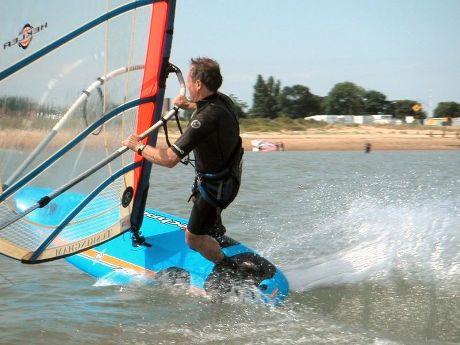
Sheet "Feather"
This "sheet feather" is a lever arm with a pulley and handle at the top end and a ball joint at the bottom end allowing the lever arm to rotate in any dimension. The main sail sheet rope comes from a pulley on the boom then through the pulley on the lever arm and finally to the normal sheet cleat. A picture is worth a thousand words so there are a bunch of pictures below.
What this does is to allow the boat pilot to make fine adjustments to the sheet pull by pulling back and forth on the lever arm handle. This "sheet feather" only makes fine adjustments, the sheet must still be controlled conventionally using the cleat for larger adjustments. For example, if you are about to capsize, just let go of the sheet feather (it is self organizing) and uncleat the sheet at the conventional spot. If you are not sheeted in enough for the feather to work, you still need to pull in the sheet in the conventional manner. The feather is only for fine main sheet angle of attach adjustment.
There are a few reason for the sheet feather.. Slight pumping is one, dithering to find the optimum sheet position is another. The most interesting may be that this particular boat has a "sweet spot" where it is sailed at a steady low heel angle at higher boat speeds. Dinghy's are commonly sailed heeled over at low boat speeds to reduce wetted surface drag. However at higher boat speeds (like getting anywhere close to hull speed), wave making drag dominates and the boat is fastest sailed flat..
This particular boat has two benefits sailed at a low heel angle. First is that the added "high location" ballast has its maximum righting moment per added weight at low heel angles. I.e., you can extract the most power out of the sail at low heel angles because that is where you get the highest righting moment. Second is that the "lift" from a planning hull is "normal" to the hull (i.e., at a right angle). When the hull is flat on the water and at faster speeds, the hull lift vector due to movement is more aligned with gravity so would also have its maximum lifting benefit. The picture below of a windsurfer carving a turn illustrates the planning hull lift being "normal" or at a right angle to the hull bottom and in this case, is used to carve a turn by vectoring the thrust outward.

After using the sheet feather for a while now, I am finding that I can use the feather to make fine adjustments in the main sail sheet angle and keep the hull heel angle low and constant. Without fine tune adjustments to the main, and in the gusty wind I normally sail in, its a little too easy to fall out of this low drag "zone". The sheet feather makes if fairly effortless to stay in this zone. .
Below. Sheet feather in use. Note that the main sheet is still cleated at the bottom. Also note that the sheet feather pulls the sail to the side rather than down so is effective at changing the sail angle of attack.
At the bottom of the lever arm is a free rotating joint so that the lever arm can be pulled back and forth at the handle. The handle also sticks out above the pulley adding some leverage and the position where the sheet feather is grabbed affects the leverage (lower is less leverage, higher is more leverage).
When the sheet feather is released, it simply follows the main sail sheet rope and stays out of the way.
Below - at the bottom of the sheet feather rod is a nylon rod that sits in an aluminum cup. Its similar to an upside down hip joint.
The sheet is routed the same as original except for going through the additional pulley attached to the feather rod.
Below. Pulley attachment now on rev 4. The pulley in that location puts a fairly large down force on the rod so what is keeping the pulley in place must be fairly robust. This rod is 0.5 inch diameter AL.
Picture below. Not using the sheet pump.. In very light winds and at slower hull speeds where surface area drag dominates, heeling the boat "is supposed to" reduce wetted surface area. In light winds, heeling the boat involves shifting weight to the lee side of the boat (opposite of where you sit for higher winds). In this case, I just control the sail by pulling on the sheet rope (between the aft pulley on the boom and the main cleat)